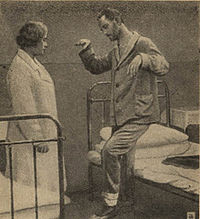
Photo from wikipedia
Stroke is the second most common medical emergency and constitutes a significant cause of global morbidity. The conventional stroke treatment strategies, including thrombolysis, antiplatelet therapy, endovascular thrombectomy, neuroprotection, neurogenesis, reducing… Click to show full abstract
Stroke is the second most common medical emergency and constitutes a significant cause of global morbidity. The conventional stroke treatment strategies, including thrombolysis, antiplatelet therapy, endovascular thrombectomy, neuroprotection, neurogenesis, reducing neuroinflammation, oxidative stress, excitotoxicity, hemostatic treatment, do not provide efficient relief to the patients due to lack of appropriate delivery systems, large doses, systemic toxicity. In this context, guiding the nanoparticles toward the ischemic tissues by making them stimuli-responsive can be a turning point in managing stroke. Hence, in this review, we first outline the basics of stroke, including its pathophysiology, factors affecting its development, current treatment therapies, and their limitations. Further, we have discussed stimuli-responsive nanotherapeutics used for diagnosing and treating stroke with challenges ahead for the safe use of nanotherapeutics.
Journal Title: Pharmaceutics
Year Published: 2023
Link to full text (if available)
Share on Social Media: Sign Up to like & get
recommendations!